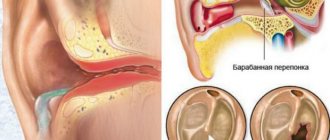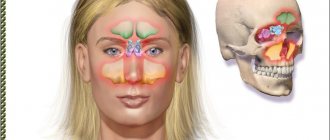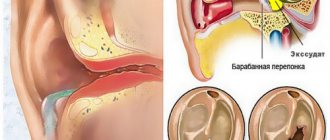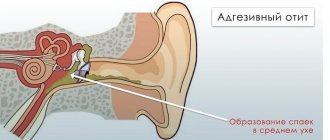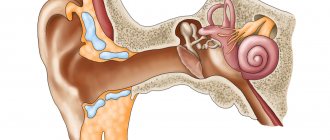What is the disease
Ear mesotympanitis is characterized by damage to the middle and lower parts of the eardrum, perforation, hyperemia, and the release of purulent exudate from the hearing organs. This disease is one of the types of otitis media in a chronic form.
The inflammation that develops during the disease extends only to the mucous membranes. Therefore, if treatment for mesotympanitis is started in a timely manner, the prognosis will always be favorable.
Only timely started therapy will help to resist the development of complications in the form of complete hearing loss, damage to bone tissue, proliferation of granulation, polyps and reduce, or completely eliminate, exacerbations.
The ICD code for mesotympanitis is H66.1: “Tubitympanic purulent otitis media of a chronic nature.”
The disease can cause serious complications. The percentage of deaths with a long course and ignoring the symptoms of the disease varies between 15-25.
Rarely, but found in medical practice, bilateral mesotympanitis - chronic or acute. Develops as a result of infection spreading to the other ear. In most cases, the disease is unilateral – right-sided, left-sided mesotympanitis.
Causes of chronic form of suppurative otitis media
Pain in the auricle or purulence from the ears may occur due to infection. In most cases, various bacteria, viruses and fungi enter the middle ear area through the nasopharynx. Therefore, special attention should be paid to diseases such as sinusitis, tonsillitis or other diseases of the upper respiratory tract. But here it is worth noting that even a common cold can easily provoke the development of purulent otitis media. Hearing impairment or complications may occur due to injury. This is another reason that increases the risk of this disease. In addition, you should not discount hypothermia in the cold season or diving into open bodies of water, where you can easily catch any infection.
What causes the development of mesotympanitis?
Ear mesotympanitis develops due to infection. Pathogenic agents that can cause disease are as follows:
- anaerobes;
- staphylococci;
- streptococci;
- mushrooms.
Exacerbation of the disease occurs due to exposure to provoking factors:
- weakened immune system;
- presence of concomitant diseases;
- hypothermia of the body;
- deformed nasal septum;
- frequent ARVI.
An infection can penetrate into the tympanic cavity in several ways:
- Exogenous. Microbes enter the ear cavity with water or after hypothermia.
- Endogenous, that is, from foci of infection. This could be caries, tonsillitis, sinusitis, etc.
Depending on the side of the lesion, the disease can be right-sided or left-sided. The bilateral form develops due to the transfer of infection from the diseased ear to the healthy one.
Form of the disease
Patients have characteristic signs of chronic mesotympanitis, when purulent mucous contents accumulate in the middle ear cavity. In this case, the eardrum ruptures, and all the fluid rushes out. But even with a benign form of the lesion, targeted treatment is necessary, otherwise the pathology can cause inflammation of the bone tissue and the formation of polyps inside it. The official name of the disease is tubotympanic suppurative otitis media. Based on the classification, appropriate appointments are made, but it is important to accurately establish the true diagnosis, which will be confirmed by appropriate examinations and tests.
Causes of inflammation
The main cause of the development of the disease is infection in the ear. Experts include microbes that can cause a pathological process:
- streptococci;
- fungi;
- staphylococci;
- pathogens of diphtheria;
- anaerobic bacteria.
Chronic purulent mesotympanitis is triggered by exposure to several components and predisposing factors:
- accompanying illnesses;
- weakened immunity;
- frequent acute respiratory viral infections with complications in the ears;
- hypothermia;
- swelling of the nasopharyngeal mucosa;
- deformation of the nasal septum.
In this case, experts distinguish between chronic left-sided mesotympanitis and right-sided mesotympanitis. The diagnosis is made depending on the side of development of the infectious process. It is possible that two ears can be affected at once, in this case the pathology is called bilateral, which is possible when the infection passes through internal or external pathways to the other ear.
Symptoms
code for mesotympanitis is H66.1. Purulent mesotympanitis is characterized by scant symptoms:
- pus is discharged from the ear for a long time;
- hearing acuity decreases;
- sensation of pulsation and noise in the organ of hearing;
- the appearance of congestion and pain;
- symptoms of intoxication.
The mucopurulent compartment, as a rule, has no odor. But after the activation of saprophytic bacteria, a putrid aroma begins to appear.
There are several stages of the pathological process:
- Latent stage – there are almost no symptoms. At the same time, negative changes occur in the body, weakness and increased fatigue appear.
- Acute stage. The reason for its occurrence is provoking factors. Development begins with perforation of the membrane, as well as the flow of pus. The patients' condition is serious, the clinical picture is pronounced.
- Remission - the membrane is scarred, hearing is restored, but temporarily. There is suppuration, but the intensity is less than before.
Chronic mesotympanitis lasts a long time. Remission is replaced by exacerbations, the duration of this condition can reach many years. Moreover, relapses always occur after accidental infection.
Fortunately, in most cases the disease has a favorable prognosis. But if left untreated, the consequences are severe - polyposis, osteitis, intracranial pathologies, etc. develop.
In adults
Hearing can be reduced to varying degrees. Some hear whispers at a distance of several centimeters, while others perceive such speech at a fairly far distance. This depends on how severely the mucous membrane is affected, as well as on the amount of pus. At high atmospheric pressure, patients feel much better.
Signs in a child
The disease occurs in 1.4-6.9% of cases in school-age children among all forms of otitis. The main complaint is tinnitus. Hearing loss may not be permanent. With exacerbation, hearing may improve. This is due to the screening of the round window.
Over time, the toxic effect of inflammatory products leads to a worsening of the course. In children, there is a violation of drainage and ventilation functions. Especially against the background of the development of infections in the nasopharynx. Additionally, there is a change in the tympanic opening of the auditory tube.
Treatment of chronic otitis media
Treatment of chronic otitis media
Treatment of chronic otitis takes a long time and sometimes requires surgical intervention. Along with drug treatment, the doctor may recommend traditional medicine. However, there is no need to self-medicate, otherwise you can worsen the situation.
A clear example is the desire of patients without knowing the diagnosis to warm up the sore ear, although this can cause the accumulated pus to rush directly to the brain.
First, you need to reduce the risk of bacteria getting into your ear. Most often, inflammation intensifies when exposed to water. Therefore, diving and visiting beaches is strictly prohibited for the patient. You can wash in the shower after putting cotton wool in your ear. Further treatment depends on the degree of development of the disease: whether only the mucous membranes are affected, or whether the infection has also affected bone tissue.
Antibiotic ear drops will help relieve inflammation. You should only use the drops prescribed by your doctor. They should not contain alcohol or other aggressive substances that can lead to hearing loss. It is not recommended to rinse the ear on your own; for this it is better to contact an otolaryngologist.
If conservative treatment does not help, the doctor will suggest surgery, which is to restore the integrity of the eardrum and prevent infection from getting inside.
The operation is performed under general anesthesia. There are two possible ways to perform the operation: through the ear canal and through an incision behind the ear. The operation will not completely restore hearing, but it will significantly improve it. Surgery can also remove polyps and tumors that appear as a result of inflammation.
Purulent otitis is almost always treated only surgically. Conservative treatment is considered only as preparation for surgery. When treating otitis, it is important to get rid of all foci of infection: inflammation of the nose and nasopharynx, sinusitis.
Discharge from the ear with an unpleasant odor: causes and treatment
After the operation, the patient needs to stay in the hospital for about 2 weeks. Full recovery occurs after 2-3 months. Physiotherapy and vitamin therapy are also indicated for patients.
Possible complications
All complications arising from mesotympanitis are usually divided into two main groups: intracranial and extracranial. The first include meningitis, encephalitis, brain abscesses, etc. Their development is caused by the destruction of the upper wall of the tympanic cavity with the subsequent spread of bacterial flora and purulent masses directly to the meninges. The group of extracranial complications includes subperiosteal abscess, mastoiditis, labyrinthitis, and facial nerve paresis. The mechanism of their development is also based on purulent melting of the walls of the middle ear, but with the involvement of the orbit, mastoid process, and structures that form the facial nerve canal or labyrinth in the pathological process. In the latter case, profound sensorineural hearing loss often occurs in parallel. Against the background of immunodeficiency states, there is a high risk of generalization of infection and the development of otogenic sepsis.
Etiology
Chronic otitis media develops on the basis of the acute form of the disease and with frequent episodes of inflammation of the tympanic cavity. The initial causes of the formation of such a disease are infection or mechanical damage.
Pathogenic microbes first infect the eardrum, nasopharynx, and then the ear. Often, doctors diagnose the progression of the disease in people due to the proliferation of bacteria such as streptococci, as well as influenza, parainfluenza and rhinovirus viruses.
The disease forms in the human ear cavity for certain reasons:
- scars in the ear due to recurrent exacerbations;
- dysfunction of the auditory tube;
- infectious diseases, such as scarlet fever.
Frequent blowing of the nose with both nostrils at once can also be a provoking factor. The nasal and ear passages are interconnected, so if the nasal mucosa is affected or sinusitis begins, then the development of otitis is quite possible.
The reasons for the transition of acute otitis to chronic can be:
- inflammatory diseases of the ENT organs;
- difficulty in nasal breathing;
- diabetes;
- immunodeficiencies;
- prolonged use of chemotherapy drugs;
- nicotine and alcohol;
- unbalanced diet;
- unsuitable climate.
In children, chronic purulent otitis media develops from an infection that affects unstable immunity. Also, a provoking factor can be the structural features of the ear and nasal septum, poor nutrition and lack of vitamins in the body. The following can contribute to the progression of the disease:
- hypothermia;
- pressure changes;
- cold;
- water getting into the ear.
Phases
Mesotympanitis, like many other ailments, has several forms:
- spicy,
- chronic.
With proper treatment, remission occurs. During this period, hearing is restored and the eardrum is gradually regenerated.
Acute
Pus appears and the eardrum ruptures. This phase can also appear during long-term remission under the influence of unfavorable factors.
In its course, this form resembles acute otitis media. During an exacerbation, there is a lot of pus, the temperature rises, and patients complain of pain in the corresponding half of the head.
Chronic
It occurs without any special symptoms. Often a person does not know that changes are occurring. A persistent hole in the eardrum impairs hearing by approximately 20-30 dB.
Mucous discharge from the ear continues for years, without causing concern to the patient, without leading to serious consequences. Periodically, suppuration stops, but when immunity decreases, it resumes.
Clinical picture
Chronic mesotympanitis, the treatment of which must be comprehensive, worsens, as a rule, after a viral infection, hypothermia, or penetration of water into the ear cavity.
The first sign characterizing the development of pathology is unilateral ear congestion. Bilateral chronic mesotympanitis (what kind of disease this is is indicated above) is characterized by the development of a purulent inflammatory process in both auditory organs at once. Some patients experience hearing loss with each subsequent exacerbation.
The development of the inflammatory process is indicated by the occurrence of intoxication signs in the form of:
- increase in body temperature to 39ͦС;
- headache;
- drowsiness;
- general weakness;
- ailments.
In addition, discharge from the ear can indicate that chronic right-sided mesotympanitis, just like left-sided mesotympanitis, is entering the acute stage. They have a different character - from a small amount of transparent mucus to abundant putrefactive secretion. Minor spotting may occur when polyps bleed.
Also observed with the disease:
- congestion in the affected ear;
- pain, discomfort;
- noise resembling a hum (with serious damage to the eardrum);
- whistle, squeak, ringing;
- dull headache radiating to the back of the head and temple.
Most patients experience vestibular disorders in the form of dizziness, disorientation, and loss of stability. These signs appear mainly after physical activity, bending the body, head, and sharp turns. Rarely, symptoms occur in patients at rest.
In what stages does ear disease occur?
- Spicy. This stage is characterized by the severity of symptoms - signs of intoxication, discharge of pus, pain.
- Hidden stage. Symptoms of mesotympanitis are almost completely absent. Slight weakness and fatigue are possible.
- Remission. At this stage, the membrane is overgrown with connective tissue. Hearing is restored for a short period of time, pus flows out in small quantities.
Mesotempanitis is a disease that has a chronic and long-lasting course. Exacerbations occur after suffering from infectious diseases.
It is worth noting that the prognosis for the chronic form is generally favorable. But only in case of timely treatment. Long-term absence of drug therapy will lead to complications. They are divided into 2 groups:
- Developing inside the skull. Meningitis, encephalitis, brain abscess. Caused by the spread of bacterial microflora to the meninges.
- Not affecting the internal cavity of the skull. Facial nerve paresis, mastoiditis, labyrinthitis, sensorineural hearing loss.
Symptoms characteristic of purulent otitis media
Immediate treatment of chronic suppurative otitis media should be carried out for the following symptoms:
- dizziness (frequent or recurring with colds), pain, both in the occipital and temporal parts of the head, and in the forehead;
- sharp shooting pain radiating to the eye or jaw;
- noise or congestion in the ears;
- the appearance of suppuration from the auricle (there may be bloody discharge);
- hearing loss or decreased hearing function (this progressive process, without timely measures taken, can lead to a significant decrease in hearing function).
It should be noted that subjective symptoms that are not accompanied by exacerbation are very often insignificant and therefore patients do not pay much attention to them. A reminder of the disease can be purulent discharge, which occurs only from time to time, and an unpleasant odor from the sore ear. In addition, the patient practically does not feel any problems with hearing, especially if the disease affects only one ear, the temperature remains within normal limits and the general condition is quite normal. But despite this, treatment of chronic suppurative otitis media should begin as early as possible.
During the exacerbation phase, the patient may experience more frequent pus discharge. As for the degree of pain, if outside of an exacerbation they were moderate, during an exacerbation they become more acute. In many cases, an exacerbation can be triggered by rhinitis, pharyngitis, laryngitis, sore throat, ARVI, or penetration of water into the auricle. As the disease progresses, the patient may experience pulsation in the ears and fever.
Pathogenesis
Epitympanitis is a complication of acute bacterial or fungal inflammation of the upper epitympanic space. It is characterized by the formation of a defect in the tympanic membrane in its loose part, or, less commonly, a bone fistula. In contrast to mesotympanitis, with this variant of CGSO, damage occurs not only to the mucous membranes, but also to regional bone structures. Depending on the predominance of certain morphological changes, 2 forms of the disease are distinguished: purulent-necrotic and cholesteatoma. In the first case, pronounced caries of the attic, aditus, cave, cellular structures of the mastoid process and auditory ossicles is formed. The second option is accompanied by the formation of cholesteatoma. This is a tumor-like structure consisting of an accumulation of cholesterol crystals, keratin, exfoliated horny epithelium and breakdown products of the listed substances (including Purines - skatole, indole). Outside, it is surrounded by a matrix - a capsule of connective tissue.
Forecasts of purulent otitis media at the chronic stage
Timely medical measures for purulent lesions in the ears can ensure recovery. And it will not be a terrible secret to anyone that those who begin treatment immediately after the first signs of the disease appear have a better chance of regaining their hearing and stopping further destruction and complications. In addition, each patient must clearly understand that advanced cases will lead to bone destruction and hearing loss. At the same time, methods that were effective in the early stages of the disease will no longer be useless. Therefore, in order to restore hearing, you will have to resort to reconstructive operations. Today, medicine has gone further and with the most disappointing results, patients undergo hearing aids.
Diagnostics
Making a diagnosis of mesotympanitis is usually not difficult. This is facilitated by the characteristic clinical picture of the disease and the presence of specific changes, which are determined by routine diagnostic methods in otolaryngology. A complete examination of the patient includes: • Analysis of complaints and medical history.
In addition to signs of conductive hearing loss and otorrhea in the anamnesis, the patient almost always has a previous history of acute purulent otitis media or exacerbation of mesotympanitis.
The otolaryngologist also clarifies the presence of predisposing factors or diseases. • Otoscopy.
The otoscopic picture in this variant of chronic urinary tract obstruction is characterized by the presence of a through hole in the stretched area of the eardrum, from which pathological masses are released.
General hyperemia, swelling of the edges of the perforation hole, and, less often, granulation growths are determined. • Otomicroscopy or otoendoscopy.
The study allows you to visualize the presence of tympanosclerotic foci or petrification, tympanofibrosis, retraction pockets, mucositis, polypous changes in the mucous membranes, determine caries or purulent melting of the auditory ossicles, destruction of the attic and aditus, and the development of cholesteatoma.
• Tuning fork research.
During the Rinne test, a patient with mesotympanitis perceives the sound of a tuning fork louder when the stem is placed on the mastoid process.
According to the results of the Weber test, the sound produced by a tuning fork is better heard from the side of the affected ear. Changes in test results indicate concomitant damage to the sound-receiving apparatus. • Pure-tone threshold audiometry.
With isolated damage to the eardrum and/or chain of auditory ossicles, a progressive depression of the air conduction curve is observed on the audiogram.
When the pathological process spreads into the labyrinth, damage to the sound-perceiving system occurs, which is reflected by a parallel deterioration in bone perception of sound. • Lab tests.
In a general blood test for mesotympanitis, an increase in the level of leukocytes over 10 × 109/l is determined with a shift in the leukocyte formula to the left, and an increase in ESR.
Bacterial inoculation of pathological masses secreted from the ear is carried out, and the sensitivity of the inoculated flora to antibiotics is determined. • Radiation research methods.
A CT scan of the temporal bones is usually used, which allows visualization of damage to the mucous membranes of the middle ear, the formation of scars near the auditory ossicles, melting of the long stalk or body of the incus, and superstructures of the stapes. With the development of complications, deformation and destruction of the walls of the roof of the tympanic cavity or cave, the facial nerve canal and the formation of labyrinthine fistulas occur. MRI of the temporal bones is less commonly used for detailed diagnosis of the cholesteatoma process and its differentiation with other pathological changes.
Differential diagnosis
Differential diagnosis of epitympanitis is carried out with myringitis, cholesteatoma of the external auditory canal and chemodectoma. With isolated inflammation of the tympanic membrane, its hyperemia and thickening without perforations are visualized. With cholesteatoma of the external ear, there is no hearing impairment, and CT shows destruction of the lower wall of the auditory canal. With a glomus tumor, the distinctive clinical symptom is the patient's perception of a pulsating noise in the absence of objective signs of lesions in the middle or outer ear.
Classification of the disease
Chronic otitis media
Clinicians have found that chronic otitis media is of 3 types:
- chronic suppurative otitis media (CSOM) - provoked by bacteria. It is divided into two more subtypes - mesotympanitis, in which only the tympanic cavity is damaged, but the bone is not inflamed, and epitympanitis, characterized by bone damage;
- exudative otitis - for two or more months, a viscous fluid accumulates in the tympanic cavity. In this case, the membrane is not damaged, but the functioning of the auditory tube may be severely impaired in a person;
- chronic adhesive otitis - scars appear in the tympanic cavity, as well as on the membrane, all the auditory ossicles fuse together, which provokes a significant deterioration in hearing. This form progresses from frequent relapses of the disease or with a prolonged course of the exudative form.
According to the direction of the pain syndrome, doctors divide into three main types:
- external – often formed from mechanical damage to the auricle and external auditory canal;
- medium - appearance in the tympanic cavity, auditory tube and mastoid process;
- internal - untreated otitis of the previous form provokes damage to the vestibular apparatus.
At moments of exacerbation, the pathology goes through several stages of development:
- inflammatory, also called eustachitis, - inflammation forms in the auditory tube;
- catarrhal, inflammation begins on the membrane of the middle ear;
- deformative, manifests itself in the form of purulent clots in the middle ear;
- post-perforation, purulent accumulations begin to flow from the ear;
- reparative, inflamed areas are reduced, the affected areas are covered with scars.
Chronic otitis media (mesotympanitis/epitympanitis)
If acute inflammation of the middle ear is primarily pain, then chronic inflammation is irreversible hearing impairment. For this reason, to treat otitis media, it is necessary to consult a specialist in a timely manner. Acute otitis media that lasts for 4 weeks or more is a risk of inflammation becoming chronic.
How does chronic otitis media develop?
Chronic otitis media is a chronic inflammation of the tympanic cavity (sometimes with damage to the bone walls - caries), which is characterized by hearing loss and periodic suppuration.
The development of the disease can be represented in three stages:
- as a result of infection, purulent discharge is formed in the tympanic cavity, and ear pain appears;
- accumulating, pus gradually deforms the eardrum, until it ruptures (perforation);
- If there is a perforation of the eardrum, hearing is reduced, and pus can pour into the external auditory canal.
After the formation of perforation, the pain ceases to bother you, and the pressure in the tympanic cavity decreases. However, this does not mean that you do not need to see a doctor - the inflammation has not gone away.
Treatment of acute otitis media
Acute otitis media is treated depending on the stage and, as a rule, on an outpatient basis. If complications develop, hospitalization of the patient is indicated. To relieve pain in the preperforative stage of acute otitis media, ear drops containing anesthetics are used. It is effective to instill drops heated to 38-39 ° C, followed by closing the ear canal with cotton wool and Vaseline, which is removed after a few hours. Turundas moistened with an alcoholic solution of boric acid are also used. To relieve swelling and improve the drainage function of the auditory tube, antihistamines and nasal vasoconstrictor drops are prescribed: oxymetazoline, xylometazoline, naphazoline, tetrizoline, xylometazoline.
General therapy for patients with acute otitis media is carried out with anti-inflammatory drugs: diclofenac, ibufen, etc. In case of increased body temperature and intense pain, antibiotic therapy is indicated. The drugs of choice are amoxicillin, cefuroxin, spiramycin. Once you start taking an antibiotic, you need to drink it for 7-10 days, since early cessation of antibiotic therapy can lead to relapses and complications, chronic otitis media, and the formation of adhesions inside the tympanic cavity.
A good effect in the pre-perforation stage of acute otitis media is obtained by blowing the auditory tube according to Politzer and washing the middle ear with antibiotic solutions in combination with glucocorticosteroid drugs. Protrusion of the eardrum during treatment indicates that despite all therapeutic measures, a large amount of pus accumulates in the tympanic cavity. This condition is fraught with the development of complications and requires paracentesis of the eardrum.
In the perforated stage of acute otitis media, along with the use of antihistamines, vasoconstrictors and antibacterial agents, toilet of the external ear and transtympanic administration of drugs are carried out. To reduce swelling and secretion of the mucous membrane, fenspiride is used, and mucolytics (acetylcysteine, herbal preparations) are used to thin out thick secretions. Physiotherapeutic treatment is prescribed: ultraviolet irradiation, UHF and laser therapy.
Treatment in the reparative stage of acute otitis media is aimed at preventing the formation of adhesions, restoring the functions of the auditory tube, and increasing the body's defenses. They use blowing of the auditory tube, introducing proteolytic enzymes into the tympanic cavity through it, pneumomassage of the eardrum, ultraphonophoresis with hyaluronidase, vitamin therapy, taking biostimulants (royal jelly, calf blood hemoderivat).
Symptoms of the disease
Symptoms of chronic otitis may vary significantly in each individual case. This depends on the degree of damage to the eardrum, as well as the general state of the immune system. The main signs of the disease include the following health problems:
- Pus. If purulent otitis is observed, then the patient is bothered by profuse purulent discharge from the ear . This discharge is foul-smelling and may contain a small amount of blood. The discharge of pus from the ear canal is a very alarming sign, however, there is a positive side. If the pus drains out, there is less chance that it will get inside and cause inflammation of the brain.
- Hearing loss. Perforation of the eardrum always leads to hearing impairment, and if polyps grow inside, then hearing becomes even more impaired.
- Strong pain. Sometimes people complain that they have a shooting in their ear. Yes, during acute otitis, the pain in the ears can be so severe that a person literally screams every time a lumbago occurs. In chronic otitis media, the pain is not very pronounced and appears irregularly;
- Stuffiness in the inflamed ear. Patients note that there is as if there is water in the ear. Out of ignorance, many patients try to clean their ears, but doing this is not recommended.
- Noises. If the ear is blocked, then there is a constant sensation of a certain noise in the head, which can be compared to a shell attached to the ear. We can say that this is not a very unpleasant symptom, but it is one that often irritates people, because when talking, their voice echoes in their head.
- Dizziness and migraine. Inflammation occurs very close to the membranes of the brain, which explains the lack of coordination, irritability and frequent migraines.
- Dysfunction of the facial muscles. This symptom does not appear immediately, but when the disease is already advanced. Facial muscles become inflamed and stop working properly.
In addition, in patients with otitis media, body temperature often rises, this is how the body reacts to the inflammatory process . Most often, high fever is observed in young children who suffer from otitis media.
With chronic otitis media, the patient's general condition is impaired. The person becomes weak, sleep is disturbed and performance is noticeably reduced.
Causes of pathology
Chronic otitis media is always preceded by acute otitis, but the root cause of this pathology is infection or ear injury. Pathogenic microorganisms can directly infect the tympanic membrane or nasopharynx, and then penetrate into the middle ear. Particularly dangerous pathogens include influenza virus, Haemophilus influenzae, streptococcus, rhinovirus and parainfluenza. So, if a person often suffers from tonsillitis, then he has a high probability of getting otitis media in addition.
The bad habit of strongly blowing your nose, especially with both nostrils at the same time, can also lead to a perforation of the eardrum and subsequent inflammation of the middle ear. Do not forget that the nose and ears are directly connected to each other, so rhinitis or sinusitis can also subsequently cause chronic otitis media.
Strong surges in pressure, which are observed during takeoff and landing of an airplane, as well as during a sharp dive under water, can also lead to various inflammatory processes in the ears.
Young children often suffer from otitis due to the structural features of the nasopharynx and hearing organs, as well as due to a weak immune system. If the child is malnourished, as well as lacking vitamins, the risk of getting sick increases significantly.
In young children, otitis media can be caused by hypothermia, respiratory illnesses, and even drafts.
For children and people with weakened immune systems, passive smoking is very harmful, as it reduces immunity . As a result of constant inhalation of harmful tobacco smoke, the risk of getting otitis media increases many times over, and the disease often becomes chronic.
Injuries to the tympanic membrane often lead to otitis media. This happens when a person cleans their ears with sharp objects. It is worth considering that non-penetrating wounds are also dangerous.
Therapeutic methods for chronic otitis media
To diagnose chronic otitis and prescribe treatment, you should be patient. The duration of each stage of treatment for chronic inflammation will be approximately 2 times longer than in the acute form of the disease. In order to completely relieve the symptoms of the disease, it may take up to 6 months.
Please note that we are not talking about a complete cure for chronic otitis media, but only about introducing it into a state of remission, in which nothing bothers the patient for a long time. In order to deactivate the infection as much as possible and increase the body’s resistance, the patient should remember some therapeutic measures:
- Using warming compresses based on alcohol or vodka near the entrance to the ear canal. Fabric bags with hot salt or sand that have not had time to cool after preparing the herbal decoction and preparations specially designed for this purpose are also suitable for manipulations.
- Regular insertion of cotton swabs soaked in saline solution into the ear canals. Such actions stimulate blood circulation and relieve the symptoms of chronic otitis media. The procedure can be performed daily for several months.
- Sanitation of the nasal cavity with salt water in the mornings and moderately warm water in the evenings.
- Mastering yogic practices, performing shoulder and head stands. These exercises provide intense blood flow to the auditory organ, especially the outer and middle parts of the ear. Please note that such training is prohibited if you have any neck pathologies.
- Compliance with hygiene standards, sanitation of the oral cavity. In addition to brushing your teeth, you need to perform a high-quality massage of your cheeks and gums. The lower gum should be massaged from bottom to top, and the upper gum, on the contrary, from top to bottom. At the end of the procedure, it is recommended to rinse your mouth with a salt solution. You can easily prepare it yourself: add 200 ml of water to a teaspoon of salt and mix well.
- Check with your doctor to see if you can visit the steam room. If the answer is yes, then perform bath procedures in accordance with your doctor’s recommendations a couple of times a week.
- Rinse your mouth and throat daily before bed. For this purpose, you can use furatsilin or a special collection. The procedures should last from several weeks to several months. These actions serve not only as an excellent prevention of otitis media, but are also very effective in preventing chronic tonsillitis and other throat diseases.
Important to remember! The infection can be put into a state of paralysis for a while. In this case, the patient will feel imaginary improvements and try to stop treatment. This cannot be done, because the lack of therapy will lead to reactivation of the disease and its transition to a more dangerous stage.
People suffering from chronic otitis need to undergo a course of treatment every time they notice even minor purulent discharge from the ear.


